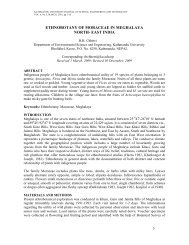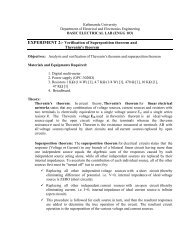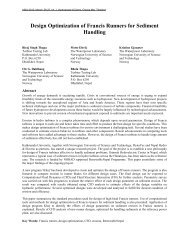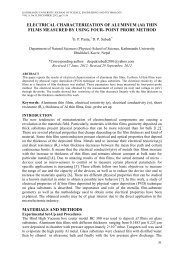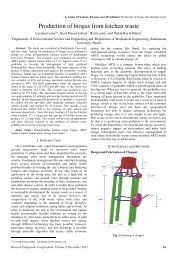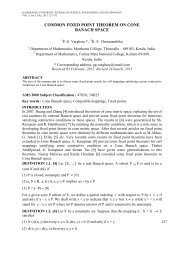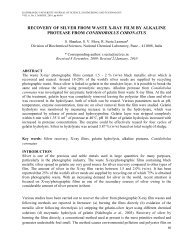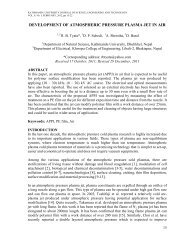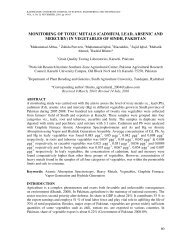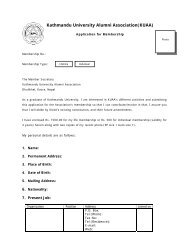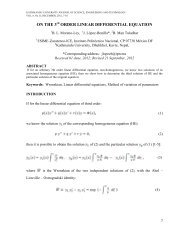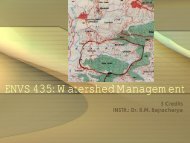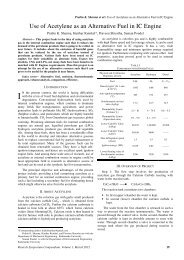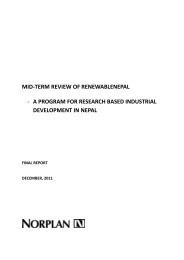ethnoveterinary practices of some plant species by ethnic
ethnoveterinary practices of some plant species by ethnic
ethnoveterinary practices of some plant species by ethnic
Create successful ePaper yourself
Turn your PDF publications into a flip-book with our unique Google optimized e-Paper software.
KATHMANDU UNIVERSITY JOURNAL OF SCIENCE, ENGINEERING AND TECHNOLOGYVOL. 8, No. I, FEBRUARY, 2012, pp 44-50ETHNOVETERINARY PRACTICES OF SOME PLANT SPECIES BYETHNIC PEOPLE OF PARBAT DISTRICT, NEPALBirendra Malla*, R. B. ChhetriDepartment <strong>of</strong> Environmental Science and Engineering, Kathmandu University, P.O. BoxNo: 6250, Kathmandu, Dhulikhel, Kavre, Nepal*Corresponding author: b.malla@nins.edu.npReceived 13 September, 2011; Revised 16 January, 2012ABSTRACTIn Parbat district, tribal communities rear livestock mostly cattle, buffalo, goats, sheep etc. Most <strong>of</strong> the timeanimal diseases are treated <strong>by</strong> the uses <strong>of</strong> local herbal medicines extracted from the <strong>plant</strong>s. All together 21 <strong>plant</strong><strong>species</strong> belonging to 19 families are being identified having used to treat different veterinary diseases like;injury, poisoning, foot and mouth, wounds, stomach disorder, antiworms and bone facture <strong>of</strong> animals. These<strong>ethnoveterinary</strong> <strong>plant</strong>s <strong>species</strong> are normally collected from near<strong>by</strong> forest or natural vegetation. Some <strong>of</strong> themlike, Acorus calamus, Cuscuta reflexa, Schima wallichii, Fraxinus floribunda etc are even domesticated <strong>by</strong>them in near<strong>by</strong> cropland therefore such <strong>plant</strong>s are readily available at any time.Keywords: Ethnoveterinary, <strong>plant</strong> <strong>species</strong>, indigenous knowledge, Parbat district, NepalINTRODUCTIONEthnoveterinary research and development is a holistic inter-disciplinary study <strong>of</strong> indigenousknowledge and associated skills, <strong>practices</strong>, beliefs and social structures pertaining to thehealthcare husbandry income producing animals, has emerged as a fertile field for generationand transfer appropriate and sustainable veterinary alternatives to the stock raisers. The term<strong>ethnoveterinary</strong> was firstly applied and used [1]. She defined it as an indigenous knowledge,abilities and methods for caring, for healing and managing livestock. Ethnoveterinary insimple terms, is supposed to be a sub-discipline <strong>of</strong> ethnoecology that simply means theecological wisdom <strong>of</strong> local people regarding animals healthcare [2]. Ancient animalhusbandry systems and <strong>practices</strong> prevalent for the treatment <strong>of</strong> livestock diseases are stillrelevant today. Some ethnobotanists have recorded traditional knowledge on <strong>ethnoveterinary</strong><strong>practices</strong> <strong>by</strong> the tribal communities [3, 4, 5, 6, 7, 8, 9, 10].Parbat is one <strong>of</strong> the four districts <strong>of</strong> Dhaulagiri Zone in western development region <strong>of</strong>Nepal. It lies between 27° 58' N to 28° 39' N latitudes and 83° 34' E to 83° 59' E longitudescovering an area <strong>of</strong> 494 sq. km. with hills, valleys, plateaus and gorges. The major tribesinhabiting in this area are Gurung, Magar, Newar, Thakali, Kumal, Majhi, Puri, Tolange,Biswakarma, Pariyar etc. The district has sub-tropical, temperate and sub-alpine monsoontype <strong>of</strong> climate. It is traversed <strong>by</strong> two big rivers Kaligandaki and Modi as well as otherrivulets, streams and streamlets. In Parbat district, beside agriculture, animal husbandry is themain occupation <strong>of</strong> the tribal communities due to excess availability <strong>of</strong> fodders. Goats, cows,bulls, buffaloes and sheep are the main cattle <strong>of</strong> the local people in the district. The <strong>ethnic</strong>people have their own system <strong>of</strong> herbal veterinary medicines practiced since the ancient time.The cattle are let loose in the forest for grazing except for three month <strong>of</strong> the rainy season,and then they practice in dry-land agriculture.44
KATHMANDU UNIVERSITY JOURNAL OF SCIENCE, ENGINEERING AND TECHNOLOGYVOL. 8, No. I, FEBRUARY, 2012, pp 44-50Fig: 1 Map <strong>of</strong> Parbat districtMATERIALS AND METHODSPresent research was conducted to three different village development committees namely,pakhapani, lunkhudeurali and phalamkhani <strong>of</strong> Parbat district during 2010. Several visits weremade to different villages <strong>of</strong> the VDCs at monthly intervals. The rural inhabitants aredependent on forests and natural vegetation for their day to day requirements. The study wasconcentrated in different villages <strong>of</strong> the VDCs and the information regarding the usage <strong>of</strong><strong>plant</strong>s for animal healing available in the local areas were collected <strong>by</strong> directly interviewingelderly knowledgeable and experienced persons <strong>of</strong> local people, who have traditionalknowledge on these <strong>ethnoveterinary</strong> <strong>plant</strong>s in the villages. The <strong>plant</strong> specimens wereidentified with the help <strong>of</strong> local floras [11, 12, 13]. Voucher specimens have been depositedin Kathmandu University, Dhulikhel, Nepal.ENUMERATIONPlant <strong>species</strong> that are known and highly regarded in <strong>ethnoveterinary</strong> <strong>practices</strong> are enumeratedwith botanical name, vernacular name in Nepali, family name and parts used for thetreatment <strong>of</strong> various ailments.45
KATHMANDU UNIVERSITY JOURNAL OF SCIENCE, ENGINEERING AND TECHNOLOGYVOL. 8, No. I, FEBRUARY, 2012, pp 44-50Table-1 Plant <strong>species</strong> used in the treatment <strong>of</strong> animal disorders <strong>by</strong> local people <strong>of</strong> ParbatdistrictBotanical name Local name Family Parts used UsesAcorus calamus L. 'Bojho' Araceae Rhizome Paste prepared from the rhizomes isapplied on the body <strong>of</strong> animals toremove lice.Begonia picta Smith. 'Magarkanche' Begoniaceae Whole <strong>plant</strong> Plants are feed to sterile animals tohelp them conceive. Juice <strong>of</strong> the rootis applied to treat conjunctivitis <strong>of</strong>buffalos.Cleistocalyx operculatus(Robx.) Murr. & Perry'Kyamuno' Myrtaceae Leaf & Stem Juice from leaf and stem bark isapplied once a day to treat muscularswelling for a week caused <strong>by</strong>external injury <strong>of</strong> cattle.Cuscuta reflexa Roxb. 'Akasebeli' Cuscutaceae Whole <strong>plant</strong> A paste <strong>of</strong> the <strong>plant</strong> is applied twice aday to treat foot and mouth disease<strong>of</strong> cattle.Cynoglossum zeylanicumThumb. ex. Lehm.'Bhere kuro' Boraginaceae Whole <strong>plant</strong> Powder <strong>of</strong> <strong>plant</strong> mixed with waterand given to treat ringworm <strong>of</strong> goats.Root juice is applied once a day for3-4 days on cuts and wounds. Leafjuice is used as an eye drops to treatconjunctivitis.Dalbergia sissoo Roxb. 'Sissoo' Fabaceae Leaf Leaf juice is mixed with churningcurd and given to the animal fordiarrhea. Leaf paste is used for footand mouth diseases.Dioscorea deltoideaWall. ex Griseb.Drepanostachyumfalcatum (Nees)'Bhayaakur' Dioscoreaceae Tuber Tuber juice about 5-7 teaspoonstwice a day is given to treatroundworm and constipation <strong>of</strong>sheep. A paste <strong>of</strong> tuber about 30-40 gis applied to cure mastitis <strong>of</strong> cowsand buffalos.'Nigalo' Poaceae Stem bark Powder made from stem epidermismixed with egg is applied on brokenlegs <strong>of</strong> hen and cock.Euphorbia hirta L. 'Dudhejhar' Euphorbiaceae Whole <strong>plant</strong> Plants are feed as a fodder to cowsand buffalos for increasing milk.46
KATHMANDU UNIVERSITY JOURNAL OF SCIENCE, ENGINEERING AND TECHNOLOGYVOL. 8, No. I, FEBRUARY, 2012, pp 44-50Fraxinus floribundaWall.Lindera neesiana (Wall.ex Nees) Kurz.Maesa chisia Buch.-Ham. ex D. Don.Mucuna pruriens (L.)DC.'Lankuri' Oleaceae Stem bark Stem bark juice about 50 ml. twice aday is given to treat stomach disorderin sheep and goats. A paste <strong>of</strong> bark isapplied to treat broken legs and arms<strong>of</strong> cattle.'Siltimur' Lauraceae Fruit The fruit juice about 30 ml. once aday is given to treat stomach disorder<strong>of</strong> animals if they eat poisonous<strong>plant</strong>s.'Bilauni' Myrsinaceae Stem bark Juice <strong>of</strong> the stem bark is applied totreat ringworm in animals.'Kaauso' Fabaceae Leaf The leaves and its extracts are used<strong>by</strong> local people about two liters twicea day is given to animals forsnakebites.Osbeckia stellata Buch.Ham ex D. Don.'Angaru' Melastomataceae Leaf & Fruit A decoction <strong>of</strong> the leaf and fruittwice a day is given to domesticanimals when they eat poisonous<strong>plant</strong>s.Ricinus communis L. 'Ander' Euphorbiaceae Leaf The leaf powder is rubbed twice aday on the body <strong>of</strong> animals to curethe wound.Rhus javanica L. 'Bhakamilo' Anacardiaceae Fruit A decoction <strong>of</strong> fruit is administeredto cure animals foot and mouthdiseases.RumexSpreng.nepalensis'Halhale' Polygonaceae Root The root juice is used as an antidoteto food poisoning in cattle. The freshroot is pounded and the extract isgiven orally a small quantity about 6ml. instilled into nose.Salvia plebeia R.Br. 'Banbawari' Lamiaceae Leaf A paste <strong>of</strong> the leaves is applied towounds between the toes caused <strong>by</strong>prolonged walking on muddy water.Leaves are rubbed externally on feetto remove lice <strong>of</strong> cattle.Schima wallichii (DC.)Korth.SolenaLour.heterophylla'Chilaune' Theaceae Stem bark The powder <strong>of</strong> stem bark is used totreat fresh cuts and liver flukes inanimals.'Golkankree' Cucurbitaceae Whole <strong>plant</strong> The <strong>plant</strong> is considered a nutritiousfeed and also helps to increase milkproduction <strong>of</strong> cows and buffalos.Solanum indicum L. Solanaceae Leaf The leaf juice twice a day about 50ml. is given for treating ringworm incattle.47
KATHMANDU UNIVERSITY JOURNAL OF SCIENCE, ENGINEERING AND TECHNOLOGYVOL. 8, No. I, FEBRUARY, 2012, pp 44-5048
KATHMANDU UNIVERSITY JOURNAL OF SCIENCE, ENGINEERING AND TECHNOLOGYVOL. 8, No. I, FEBRUARY, 2012, pp 44-50RESULTS AND DISCUSSIONPresent research reveals <strong>ethnoveterinary</strong> uses <strong>of</strong> 21 <strong>plant</strong> <strong>species</strong> belonging to 19 familieswhich are widely used <strong>by</strong> the <strong>ethnic</strong> people <strong>of</strong> Parbat district. The tribes are highly dependenton the herbal remedies because diseases concepts and treatments differ in different societies,and even within a single community among gender, age, education and <strong>ethnic</strong>ity but in <strong>some</strong>cases, the medicinal <strong>plant</strong>s reported are claimed to treat the common diseases in the differentcommunities. It has been noted that leaves, stems and whole <strong>plant</strong> were the most frequentlyused <strong>plant</strong> parts for the treatment <strong>of</strong> various veterinary ailments followed <strong>by</strong> fruits, rhizomes,roots and tuber, in the order. The study has shown that foot and mouth diseases, foodpoisoning, ringworm, bone fracture, stomach disorder, injury, conjunctivitis, muscularswellings, diarrhea, reduce lactation, snakebites and lice etc. were common diseases amongthe domestic animals and few diseases reported as liver flukes, mastitis and conceivenesshave rare occurrence in the district. These findings need further clinical research to developnew herbal drugs for the effective treatment <strong>of</strong> different <strong>ethnoveterinary</strong> diseases in domesticanimals.ACKNOWLEDGEMENTSThe authors are deeply thanked and acknowledged to the tribal communities <strong>of</strong> Parbat districtfor sharing indigenous knowledge during the field work.REFERENCES1. McCorkle C M, An introduction to <strong>ethnoveterinary</strong> research and development. Journal<strong>of</strong> Ethnobiology 6 (1)(1986)129.2. Martin JG 1996, Ethnobotany: A People and <strong>plant</strong> conservation manual, Chapman andHall, 268.3. Bhattarai, N K 1992. Folk uses <strong>of</strong> <strong>plant</strong>s in veterinary medicine in Central Nepal.Fitoterapia 63 (6)(1992) 497.4. Manandhar, N P 2002. Plants and People <strong>of</strong> Nepal. Timber Press Portland, Oregon,USA: 63-487.5. Patil, S H & Merat, M M 2003. Ethnoveterinary <strong>practices</strong> in Satpudas <strong>of</strong> Nandurbardistrict <strong>of</strong> Maharasthra. Ethnobotay 15(2003) 103.6. Takhar, H K 2004, Folk herbal veterinary medicines <strong>of</strong> southern Rajasthan. IndiaJournal <strong>of</strong> Traditional Knowledge 4(2004)407.7. Bandyopadhyay, S & Mukherjee, S K, Ethnoveterinary medicine from Koch Bihardistrict, West Bengal. India Journal <strong>of</strong> Traditional Knowledge 4 (4)(2005) 456.8. Tripathi, H, Approaches in documenting <strong>ethnoveterinary</strong> <strong>practices</strong>. India Journal <strong>of</strong>Traditional Knowledge,5 (4)(2006) 579.49
KATHMANDU UNIVERSITY JOURNAL OF SCIENCE, ENGINEERING AND TECHNOLOGYVOL. 8, No. I, FEBRUARY, 2012, pp 44-509. Tiwari, L & Pande, P C, Ethnoveterinary medicines in Indian perspectives: Referenceto Uttarakhand, Himalaya. India Journal <strong>of</strong> Traditional Knowledge 9 (3)(2000) 611.10. Nigam, G & Sharma, N K, Ethnoveterinary <strong>plant</strong>s <strong>of</strong> Jhansi district, Uttar Pradesh.India Journal <strong>of</strong> Traditional Knowledge 9 (4)(2010) 664.11. Hara, H, Stearn, W T & Williams, L H J, An Enumeration <strong>of</strong> Flowering Plants <strong>of</strong>Nepal. Vol. I. British Museum <strong>of</strong> Natural History, London, U.K: 23-149, 1978.12. Hara, H & Williams, L H J, An Enumeration <strong>of</strong> Flowering Plants <strong>of</strong> Nepal. Vol. II.British Museum <strong>of</strong> Natural History, London, U.K: 9-210, 1979.13. Hara, H, Chater, A O & Williams, L H J, An Enumeration <strong>of</strong> Flowering Plants <strong>of</strong>Nepal. Vol. III. British Museum <strong>of</strong> Natural History, London, U.K: 9-220, 1982.50



